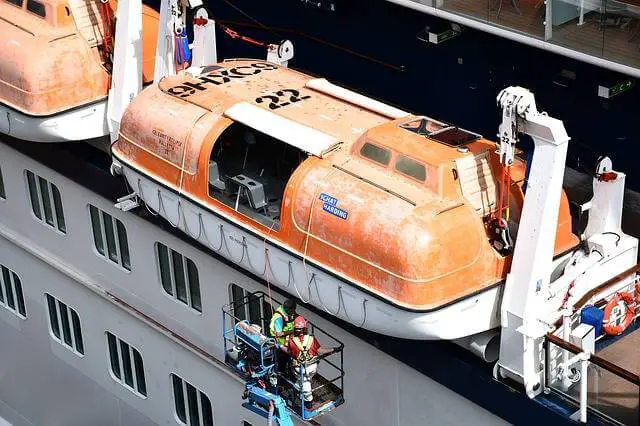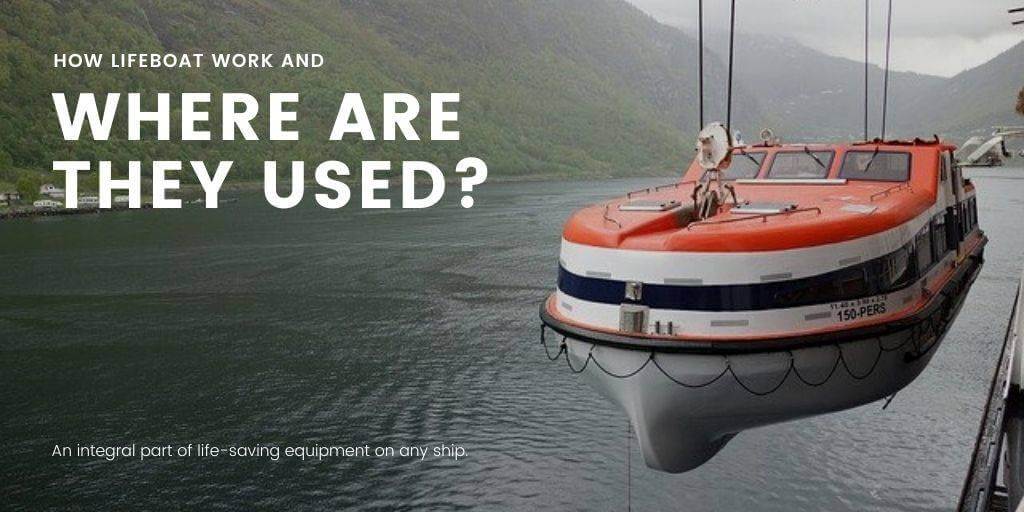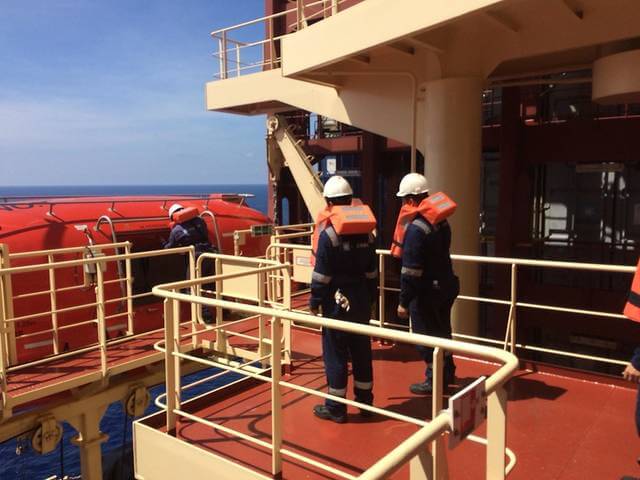Last Updated on July 2, 2020 by Amit Abhishek
A lifeboat has always been an integral part of life-saving equipment on the ship. It’s considered as the last resort to safety challenges on board ships. Thus it is important to maintain the required number of lifeboats at all times.
Lifeboats are basically a smaller boat designated for carrying out emergency abandonment of the ship. The primary objective of these lifeboats is to provide quick and easy escape from the sinking ship.
Located on the side of the ship they must be capable of lowering quickly with least resistance operating the davit system. To sustain survival at sea under SOLAS and LSA codes; each lifeboat must-have emergency rations, freshwater, first aid, tools, signaling equipment, and VHF radio.
The total number of lifeboats per ship is governed by its size, type, and a total number of crews and passengers. Based on its design and operating mechanism a lifeboat can be classified into open, closed, and free-fall types.
As the name suggests an open lifeboat is open and exposed to the environment ( sun, wind, rain ). This is the kind of lifeboat you will find on older ships. The other type is the enclosed one with a roof on top to protect against seawater currents, rain, and winds.
The last type is the heaviest and strongest of them all and are launched in a free fall directly into the waters. Because of their free-fall nature they take the least time to reach the water surface once released.
Where Lifeboat Is Used And Their Minimum Requirements?
Today enclosed life boats of various types ( semi-enclosed, fully enclosed and free fall ) are used on large ships to save the life of its crew and passengers in event of emergency abandonment of the ship.
These small boats are used along with other life saving equipment’s such as the life rafts, rescue boat and other buoyant devices. Based on the type of ship we have different minimum requirements to these life boats.
The International Convention for the Safety of Life at Sea requires an adequate number of life-saving equipment in the form of life boats, life rafts, and rescue boats accounting for at least 125% of total capacity.
The SOLAS also requires these boats to be launched with the ship listed up to 15 degrees on either side or 20 degrees on one side at 5 knots.
For large cargo ships, there should be adequate numbers of life-saving equipment ( life boats + Life rafts + Rescue Boats ) accounting for 300% of the capacity of the ship.
In which 100% of total capacity be able to embark from enclosed lifeboats. Further, the other 200% of the capacity be used by life rafts with 100% capacity on each side of the ship.
In case of passenger ships or cruise running for small international voyages i.e less than 600 miles. There should be lifeboats accounting for 30% of the total capacity and life rafts for 100% of the capacity.
For passengers ships involved in long international voyage they should have life boats accounting for 100% of the capacity with 50% on each side. Further they should also have life rafts accounting for not less than 25%.
How is lifeboat capacity calculated?
The capacity of a life boat is determined by calculating the cubic capacity for that boat ( L x b x d x 0.64 ) deducting the volume of the engine. Although it gives a fair number of passengers to be accounted; actual seating limits are governed by SOLAS convention.
As per LSA code 4.4.2.1 no lifeboat shall ever accommodate more than 150 passengers at any time. When calculating the total number of seats for a lifeboat the average weight of a person is considered to be 75 kg.
All approved life boats should accommodate at least 5 seated person with space for one injured person lying down on a stretcher. Further, they should be arranged as such to allow quick and easy embarkation and disembarkation.
For free fall life boats the carrying capacity is calculated based on the total number of seats that can be fitted without interfering with the safety, operations or means of propulsion. While maintaining automatically self-righting ability when fully loaded.
SOLAS Requirements for lifeboats
- All lifeboats should be properly constructed maintaining ample stability and sufficient freeboard.
- All life boats should have a solid hull construction and be able to maintain +ve stability when put underwater in fully loaded capacity under upright position.
- The certificate of approval with basic details like manufacturer name and address, boat model number, manufacturing date, approved passenger limit and other approval instructions are fitted on boat.
- Except in the case of free-fall lifeboats, it should have sufficient strength to withstand impact load when dropped at a velocity of 3.5 m/s from a 3 m height.
- The life and rescue boats are required to carry all pieces of equipment and rations described under SOLAS required for survival at sea under emergency conditions.
- Although the actual size and number of lifeboats on a ship are determined by the ship size; it should not be any less than 7.3 meters in length.
- Further, the vertical distance between the floor and the canopy for over 50% of the floor area be greater than 1.3 meters for boats carrying less than 9 passengers and 1.7 meters for boats carrying 24+ crew members.
- Each life boat should be made as such they can be boarded to their full capacity in less than 3 minutes without any assistance with allowance for helpless people to accommodate.
- These life vessels should have sufficient inherent buoyancy to float even when partially flooded with all its equipment and passengers on board.
- The lifeboat should be painted in an internationally accepted orange color with a glossy boot.
- Regular drills are conducted to ensure all crew and passengers are familiar with the equipment on the boat and be able to operate the engine when needed.
How are lifeboats launched?
A lifeboat is lowered or launched with the least resistance by using the gravity davit assembly. The boat is secured to the davit assembly by its two arms, boat fall and suspension block.
A gravity davit assembly consists of davit arms, over-lashing wire rope, remote control wire, boat fall, deck control device, suspension block, and link along with the handbrake to control launching speed.
The boats are secured to the davit assembly by means of wires and hook. Upon releasing the hook the boats propels away and is on its own.
Start the launching procedure by removing the electrical connection to the boat battery.
Confirm the painter is connected to the painter releasing device. Remove the over lashing wire rope and safety pin from the winch brake. open the embarkation door and embark. Once embarked lower the davit arm by using the remote control wire/lever to launch the lifeboat to waterline.
Under normal weather the hooks will auto detach under hydro static force triggering operating lever and Morse cable. In case it does not self trigger remove the safety pin on operating lever and release the hooks manually.
How lifeboat work? Starting a lifeboat engine
When starting the lifeboat engine the first thing you should do is to check the cooling water valve position. When starting at sea it should be in normal running position but on davit put this to testing position.
Further when testing you need to dip the testing water line to a container filled with water to act as the coolant. Then you also need to close the exhaust drain pipe valve and uncover the boat engine for inspection.
Do a quick visual inspection and confirm the lube oil lever is under desirable limit. Under extremely cold conditions you might also need to check its viscosity.
Then crank the engine to ensure the shaft is free from obstruction.
You can select between the two batteries given for starting the lifeboat engine. For the first battery you need to wait longer to start but it consumes less power per starting.
For the second method you do not have to wait and can start immediately. Under normal condition it is advised to use the first battery with slightly longer starting procedure.
For the first method turn the starting switch and wait for the glow light to disappear; then start the engine. For the second method with another battery you can start immediately before the glow light turn off.
Then there is also a fail safe method to start the engine by using spring start method.

Inspection and maintenance requirements for lifeboat
In 96th session of Maritime Safety Committee’s IMO various amendments are made to the SOLAS regulations III/3 and III/20; which came into effect from 1 Jan 2020.
As per new amendments more emphasis is given on the maintenance and regular inspection and testing of the life boat and associated launching appliances on board.
Inspection and maintenance tasks are divided into weekly, monthly, yearly, and on each five years routine. This routine involves tasks such as visual inspection of the inside boat, hull, canopy, painter, hatches, air support system, engine, water cooler, battery, and lifeboat equipment.
They further include operational maintenance, cleaning and testing of various lifeboat systems. The life boat itself should be lowered at frequent interval and drills be conducted for abandonment.
Lifeboat Safety Equipment
- Survival manual
- Sea Anchor
- Rustproof drinking vessel
- Compass
- Six hand flares with four rocket flares
- Day light signaling instrument
- A pair of buoyant smoke signal
- First Aid Kit
- Embarkation ladder
- Dipper
- Food rations with jack knife and tin opener.
- Anti sea sickness pills
- Radar reflector and VHF Radio
- Thermal protective aid
- A portable fire extinguisher
Also Read:
- Marine Terminology For Boat Ships & Sailors
- What Are Tugboats? Its Definition, Types And Working
- A Beginers Guide On How To Drive A Boat
- How to Survive Adrift at Sea (EMERGENCY!!)


